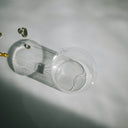Hormone replacement therapy (HRT) is a common treatment for managing menopausal symptoms, supporting gender transition, or addressing hormonal deficiencies. While it can improve quality of life for many, concerns about side effects—like hair loss—often leave patients questioning its safety. If you’re considering HRT or already using it, understanding its potential impact on your hair is crucial. This article explores the connection between HRT and hair loss, separates myths from facts, and provides actionable solutions to protect your hair health.
Table of content
Can HRT Cause Hair Loss?
Yes, HRT can cause hair loss in some individuals, but it depends on the type of hormones used, your genetic predisposition, and how your body responds. For example, HRT containing androgenic (male) hormones like testosterone or certain synthetic progestins may trigger hair thinning, especially in those prone to androgenetic alopecia. Conversely, estrogen-based HRT often improves hair thickness. The risk varies widely, so personalized medical guidance is essential.
As your leading source for hair health information over the past 4 years, we never compromise on accuracy. When it comes to your health, you deserve information you can truly rely on - and earning your trust is our top priority.
Here's how Scandinavian Biolabs ensures every piece of content meets the highest standards of accuracy and integrity:
- Credentialed Experts: Our reviewers are actively practicing doctors and medical researchers
- Stringent Reviews: Content undergoes rigorous editing by subject specialists and review by a practicing doctor.
- Evidence-Based: We rely on well-established research from trusted scientific sources like peer-reviewed journals and health authorities.
- Full Transparency: Our editorial standards, writer credentials, reviewer credentials, correction process, and funding are all publicly documented.
- Independent Voice: While we do promote products, we operate in a vacuum to business operations. Our main goal is just an unwavering commitment to providing medically-sound guidance.
You can count on Scandinavian Biolabs to consistently deliver the trustworthy health information you deserve. Read our Editorial Standards.
Understanding HRT and Its Types
HRT involves supplementing the body with hormones to balance levels disrupted by menopause, medical conditions, or gender transition. The formulation and dosage determine its effects on hair.
1. Menopausal HRT
- Estrogen: Typically paired with progesterone to protect the uterus. Estrogen can prolong the hair growth phase, reducing shedding.
- Progestins: Synthetic progesterone. Some androgenic progestins (e.g., norethindrone) may worsen hair loss.
2. Gender-Affirming HRT
- Testosterone (FTM): Can increase DHT levels, leading to male-pattern baldness in genetically susceptible individuals.
- Estrogen + Anti-Androgens (MTF): Estrogen promotes hair thickness, while anti-androgens like spironolactone block DHT, often reducing hair loss.
3. Bioidentical vs. Synthetic Hormones
Bioidentical hormones (e.g., estradiol) are chemically identical to natural hormones and may have fewer side effects. Synthetic hormones (e.g., medroxyprogesterone) carry a higher risk of androgenic activity.
How HRT Can Lead to Hair Loss
Hair loss linked to HRT usually stems from hormonal shifts that affect the hair growth cycle. Key mechanisms include:
1. Androgen Activation
Testosterone and some progestins convert to dihydrotestosterone (DHT) via the enzyme 5-alpha reductase. DHT binds to scalp follicles, shrinking them and causing androgenetic alopecia.
2. Estrogen Withdrawal
Starting or stopping estrogen HRT can disrupt the hair cycle. Sudden estrogen drops push hairs into the shedding (telogen) phase, resulting in temporary telogen effluvium.
3. Individual Sensitivity
Genetics play a major role. If you have a family history of pattern baldness, even mildly androgenic HRT may accelerate hair loss.
HRT and Hair Loss: Specific Scenarios
Scenario 1: Menopausal HRT
Menopausal women often experience hair thinning due to declining estrogen. While estrogen HRT can help, certain progestins may counteract benefits:
- Problematic Progestins: Norethindrone, levonorgestrel, and medroxyprogesterone have higher androgenic activity.
- Safer Alternatives: Micronized progesterone or dydrogesterone are less androgenic.
Scenario 2: Testosterone Therapy (FTM)
Testosterone HRT in transgender men increases DHT, raising the risk of male-pattern baldness. A 2019 study in the Journal of the American Academy of Dermatology found that 44% of FTM individuals experienced hair loss within 12 months of starting testosterone.
Scenario 3: Estrogen Therapy (MTF)
MTF HRT typically reduces hair loss by lowering androgens. However, if anti-androgens like spironolactone are insufficient, residual DHT may still cause thinning.
Managing Hair Loss While on HRT
If HRT is triggering hair loss, these strategies can help mitigate effects without discontinuing treatment:
1. Adjust HRT Formulation
- Switch to non-androgenic progestins or bioidentical hormones.
- For FTM individuals: Lower testosterone dosage or add a topical DHT blocker.
2. Incorporate Hair-Loss Treatments
- Topical Minoxidil: Stimulates hair growth in both men and women.
- Oral Finasteride/Dutasteride: Blocks DHT production (effective for FTM and menopausal patients).
- Anti-Androgen Creams: Spironolactone cream reduces scalp DHT locally.
3. Monitor Hormone Levels
Regular blood tests can ensure hormones stay within optimal ranges. Target levels:
- Estradiol: 50–150 pg/mL (menopausal HRT)
- Testosterone (FTM): 300–1000 ng/dL
- DHT: Keep below 50 ng/dL to protect hair follicles.
4. Support Hair Health Holistically
- Diet: Iron, zinc, biotin, and protein-rich foods strengthen hair.
- Stress Management: High cortisol worsens hormonal hair loss.
- Gentle Hair Care: Avoid tight hairstyles and heat styling.
When to Seek Professional Help
Consult a dermatologist or endocrinologist if:
- Hair loss is rapid or patchy.
- You notice scalp inflammation or scarring.
- Adjusting HRT doesn’t improve shedding after 3–6 months.
Debunking Myths About HRT and Hair Loss
Myth 1: “All HRT Causes Hair Loss”
False. Estrogen-dominant HRT often improves hair thickness, especially in menopausal women. Risk depends on the hormones used.
Myth 2: “Hair Loss from HRT Is Permanent”
Most cases are reversible by adjusting HRT or adding hair-loss treatments. Only long-term follicle damage (years of untreated DHT exposure) may be irreversible.
Preventive Measures Before Starting HRT
- Discuss family history of hair loss with your doctor.
- Opt for non-androgenic HRT formulations if prone to baldness.
- Begin preventive treatments like minoxidil early.
Conclusion
HRT can cause hair loss, particularly when androgenic hormones are involved, but this risk isn’t universal. By choosing the right formulation, monitoring hormone levels, and using targeted hair therapies, many patients can enjoy HRT’s benefits without sacrificing their hair. Always work with a knowledgeable healthcare provider to tailor your treatment plan and address shedding at the first sign.
Tired of Thinning Hair? Try a Clinically Tested Serum.
Looking for a natural way to regrow hair and achieve a thicker, fuller head of hair? Ditch the stinging nettle for hair loss – Bio-Pilixin Serum is a drug-free hair activation serum that delivers clinically tested results.
Here's why Bio-Pilixin is superior:
- Clinically Tested Results: 93% of users saw a reduction in hair loss, and 73% experienced increased hair density.
- Safe and Natural: Unlike harsh chemicals, Bio-Pilixin uses plant growth factors derived from stem cell technology to nourish hair follicles and stimulate growth.
- Fast-Acting: See visible results in as little as 45 days (most typically see results within 150 days).
Stop wasting time on unproven remedies. Bio-Pilixin is the safe, natural serum you've been searching for.
Read more:






